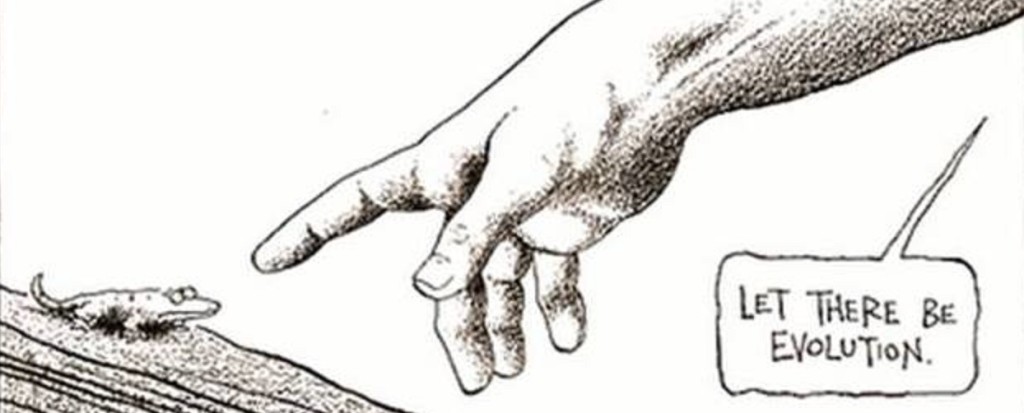
In a Nutshell…
The issue of origins is knotty topic. In order to address it properly, there are several important distinctions to keep in mind. First, the age of the universe vs evolution – the old earth does not have any bearing on the diversity of life. Second, the scientific data vs the Scriptural data – each set is evaluated with completely different concepts and rules. Third, central issues vs auxiliary issues – the age of the earth may or may not carry as much weight as an issue such as the resurrection of Christ.
In the following, we will survey three interpretations of Genesis 1 that are equally congruent with orthodox, conservative Christian beliefs: the literal calendar day interpretation, the literal day-age interpretation, and the non-literal framework interpretation. These interpretations, however, do not equally necessitate particular understandings of the scientific data and can be summarized as follows
| Interpretation | Description | Age of Earth? | Evolution? |
| Calendar Day | The days in Genesis 1 are literal, 24 hour days | Young | No* |
| Day-Age | The days in Genesis 1 are literal, eras or periods of time | Old | Maybe |
| Framework | The days in Genesis 1 are non-literal, logical moments or literary devices | Any | Yes or No |
*evolution is not logically excluded out of the calendar day view, but, it is rather implausible
Next, I rebut one objection to synthesizing creation and evolution, namely, that evolution is inherently purposeless.
The Issue
The debates over origins have become a touchstone in modern American culture, particularly cemented by the infamous Scopes Monkey Trial. This phenomenon is uniquely American as the creation debate does not seem to have as much public attention in other parts of the world, particularly the United Kingdom. Some may say that this is because the United States is the last bastion of conservative Christianity and the other Christians around the world are spineless compromisers. I don’t think this is the case and shall briefly survey three interpretations that are consistent with a conservative understanding of Scripture.
The Calendar Day View
This view is probably the most well-known, particularly in the United States. Simply put, the days described in Genesis 1 are ordinary, calendar or 24 hour long days one after another. In Genesis 1:5, the days are demarcated by a period of darkness and a period of light, just like the days we experience today. As the chapter progresses, these days are then demarcated by “evening” and “morning”.
God called the light Day, and the darkness He called Night. So the evening and the morning were the first day.
Genesis 1:5
Later, in the book of Exodus, God gives the 10 Commandments to Moses. The commandment to keep the Sabbath is explicitly grounded in the time period of the creation week.
The seventh day is a Sabbath to YHWH your God. On it you shall not do any work…for in six days YHWH made heaven and earth, the sea, and all that is in them, and rested on the seventh day. Therefore YHWH blessed the Sabbath day and made it holy.
Exodus 20:11
Lastly, the genre of Genesis is widely considered to be a historical book. There does not seem to be any warrant to consider the first chapter anything other than plain, straightforward history.
The Day-Age View
Much like the Calendar Day view, the Day-Age view takes a literal understanding to the word yom which is Hebrew for day. Among the various literal interpretations of yom is that of a long, but finite period of time, corresponding more closely to the English era or age. There are a few reasons to consider the days of Genesis 1 to be longer than ordinary days.
First, how coherent is it to think that evening and morning denote solar days if the Sun was not created until Day 4? It seems disingenuous to say these are “ordinary” days when clearly the days we experience today are demarcated by the rising and setting of the sun. This seems internally inconsistent.
Second, there seems to be entirely too much activity on Day 6 to fit within a 12 hour slot. Assuming an ordinary day with 12 hours of daylight,
- God created the animals (Genesis 1:24-25).
- God created Adam (Genesis 1:26-27; 2:7).
- God gave Adam dominion over creation (Genesis 1:28).
- God made the plants (Genesis 1:29-30).
- God planted a garden and puts Adam in it (Genesis 2:8).
- God gave Adam specific moral commands (Genesis 2:9, 16-17).
- God commanded Adam to cultivate the garden (Genesis 2:15).
- God commanded Adam to name all of the animals (Genesis 2:19-20).
- Adam got lonely (Gen. 2:18, 20).
- God put Adam into a deep sleep (Genesis 2:21).
- God created Eve (Genesis 2:22).
- God institutes marriage between Adam and Eve (Genesis 2:23-25).
Is this reasonable to think that Adam completed all of these tasks in the space of 12 hours? Naming the animals alone would take an inordinate amount of time – even if limited to just the mammals of the Levant. The plain understanding of Day 6 simply cannot reasonably be an “ordinary” day. Thus, the most natural understanding of these days is long periods of time.
The Framework View
This is a non-literal view that takes the days of Genesis 1 to be more of a logical ordering or literary structure rather than a strictly factual description of events. Understandably, it’s common for people to be uncomfortable with the idea of something non-literal in Genesis. Often, the charge is made that if Genesis 1 can’t be taken entirely literally then the entire Bible can’t be taken literally. Similarly, the issue of a non-literal opening of Genesis leads to a non-historical Adam which then unravels the theology of Romans 5. However, these are unwarranted concerns. A Scriptural passage can detail history in a framework or other poetic structure without being entirely metaphor. For example, Judges 4 and Judges 5 describe a (literal) battle that Israel fought but the chapters use two completely different styles. So, “history or mythology” is a false dichotomy. When approaching the Genesis narrative, it reads most like a Poetic-Structural narrative.
(The following material is largely based on Kirk MacGregor‘s treatment in his systematic theology).
There are several markers that are used to determine whether a passage fits in the poetic-structural genre. First, it must be chiastic or strophic in structure. These correspond roughly to poems in the form of A-B-C-A-B-C-D (strophic) and A-B-C-D-C-B-A (chiastic).
Next, it must have four of the following six characteristics:
- repetition of traditionally symbolic numbers [e.g. 7, 10, 3]
- word plays
- parallelism on the sentence level
- rhyme and meter
- imagery
- similes/metaphors.
Genesis 1-3 meets these criteria and is split into two halves, 1:1-2:4a and2:4b-3:24.
Half 1 is in the strophic form. A-B-C corresponds to Day 1, Day 2, and Day 3 which are the “forming days” i.e. God is creating the realms for the future inhabitants. The second A-B-C series corresponds to Day 4, Day 5, and Day 6 where these are the days of “filling” i.e. each realm is filled with its respective inhabitants. D corresponds to Day 7, the Sabbath which is wholly different from the rest of the creation week and operates as a termination point.
- A: God creates the realm of Light
- B: God creates the realm of Sky/Water
- C: God creates the realm of Land/Vegetation
- A: God fills Realm 1 with Luminaries
- B: God fills Realm 2 with Birds/Fish
- C: God fills Realm 3 with Land Creatures/Humanity
- D: Sabbath termination of creation event.
Half 2 is in the chiastic form where the literary symmetry is much like a parabola. The points are as follows
- A: God places humanity in the Garden
- B: God speaks bringing all the beasts of the fields, creates Eve, establishes ideal marriage relationship
- C: Temptation to forsake God and warning of spiritual death
- D: Man and woman break their initial covenant with God
- C’: Consequences of forsaking God and experience of spiritual death
- B’: God speaks cursing the snake amongst all the beasts of the field, spells out the negative implications for husband-wife relationship outside of the covenant
- A’: God banishes humanity from the Garden
Having met the first criterion, the remaining are as follows
- There are several examples of special numbers being used. Here is just a small sample: The phrases “let there be”, “make”, “and it was so” each occur 7 times in the passage. Verse 1 employs 7 Hebrew words.
- The phrase “and God saw that it was good” (which also occurs 7 times) some consider a play on words with the Hebrew phrase for “desolate” in verse 2.
- Parallelism on the sentence level is best seen in the triple repetition of verse 27: “So God created man in His image, in the image of God He created them; male and female He created them”
- The ten lines after verse 27 all hold to the same Hebrew rhyme and meter scheme
- There’s lots of dramatic imagery such as the total desolation of Earth and the Spirit of God hovering over the face of the waters. Also, the Tree of Life is strongly contrasted with the Tree of Knowledge of Good and Evil.
- Lastly, there are lots of similes and metaphors including “you will be like God”, God “walking in the Garden during the cool of day”, God “breathing into the man the breath of life”.
Given all of this background, I think it is immensely probable to believe that Genesis 1-3 is intended to be a poetic-structural narrative that is intended neither to be a straightforward historical account nor pure mythology. While these opening passages proclaim that God carefully created this universe and planet, they do not explain with precision how He accomplished this. Thus, I think it is appropriate to allow the scientific data to inform our understanding of the material origins. Lest one think that this is a compromising, liberal perspective, I point you to the work of conservative evangelical scholar Meredith G. Kline, particularly, one of his seminal works on the topic Because It Had Not Rained.
Is Evolution Inherently Purposeless?
Thus far, we have addressed only the issue of the age of the earth and the possible interpretations of Genesis 1. Next, we shall turn to an objection to evolution. Again, I’m not surveying the scientific data here; that is too daunting a task.
Some may argue that evolution cannot be integrated with creation because it is inherently random and disordered while creation is purposed and ordered. I that this objection rests on a conflation of two distinct categories which I will call the “means” and the “motive”. The “means” will refer to the mode of transforming material to its final state and the “motive” will refer to the purpose or reason for this occurrence.
So, where is the conflation? The intro video from creation.com offers a good example.
The speaker states “Creation or evolution? Design or time and chance?”. The hidden presupposition is that (1) direct creation by a deity entails design and (2) biological evolution entails purposelessness. However, this isn’t the case at all. The means by which biological diversity arises does not have much bearing (if any) on the motive. In other words, establishing the veracity of a certain means does not establish the veracity of a certain motive.
Suppose that purely materialistic processes are proven to be inadequate to explain the origination and development of life on Earth. Does this demonstrate design? I am not sure. For example, the satirical Flying Spaghetti Monster is claimed to have created many of the features on Earth by accident as a result of a hangover. It seems unlikely that this form of creation is what one would call well designed or at least designed in the sense that many creationists want to demonstrate. In this regard, it seems rather apparent that the means of creation do not demonstrate anything about the motive for creation. A complete scientific falsification of evolutionary theory would still seem to be vulnerable to the objection that the Intelligent Designer created the universe without any real overarching purpose (perhaps s/he was bored, drunk, insert your favorite arbitrary reason). This would be the case if it weren’t for the fact that, at least in the Christian worldview, this designer has spoken (Hebrews 1:2-3).
The fact that God has spoken is, I think, the source from which motive is truly derived. God created the universe specifically as the means for calling His elect to justification and conforming them to the image of the Son (Romans 8:28-30). While certain degrees of purpose or telos can be derived from the natural sciences, it is the revelation of Scripture that provides the Christian with the warrant for God’s motives in creating the world. The upshot here is that if there are independent reasons for accepting God’s existence and the truth of Scripture, then, the reality of design can be warranted independent of the means by which biological diversity arose. Conversely, the reality of evolution as the means of achieving biological diversity shouldn’t undermine the conviction of purpose.
How then can this “designed evolution” be conceived? The typical response is that the process of evolution does not appear to be designed or have any particular goal, so, to call it designed is a contradiction in terms. However, I think that a rebuttal can be formulated by analogy. How often is the course of human history perceived to be completely out of control or undirected or even going opposite of expectations? By all appearances, human history does not have an obvious end goal. Nevertheless, aren’t Christians still committed to the idea that God is in control of the events of human history, guiding them to an expected end? Of course, but the warrant for this isn’t found from examining history and deriving a purpose. Rather, it is warranted by what has been revealed in passages such as Isaiah 46:8-10
“Remember this and stand firm,
recall it to mind, you transgressors,
remember the former things of old;
for I am God, and there is no other;
I am God, and there is none like me,
declaring the end from the beginning
and from ancient times things not yet done,
saying, ‘My counsel shall stand,
and I will accomplish all my purpose,’
calling a bird of prey from the east,
the man of my counsel from a far country.
I have spoken, and I will bring it to pass;
I have purposed, and I will do it.
If God is in control of a seemingly purposeless enterprise such as human history, then, it seems perfectly consistent to posit His control over the similarly seemingly purposeless enterprise of evolution.
Conclusion
We have surveyed three of many legitimate, Scripturally faithful understandings of Genesis 1 available to Christians of a conservative persuasion. I gave a defense of my own perspective, namely the framework view which is consistent with both and evolutionary understanding of human origins and an ancient universe. In the second half, we looked at a potential philosophical objection to the harmonization of creation and evolution. I illustrated that the idea of purposed/directed evolution appears to be an intrinsically consistent idea or at least as consistent as purposed/directed human history. Ultimately, it is important to keep the main thing the main thing. As Christians, we should not get bogged down in these debates over origins. While some of the related issues can be bear more weight than others, it is important that we remain focused on the central message of Christ and the historicity of his death on a cross and subsequent resurrection.





